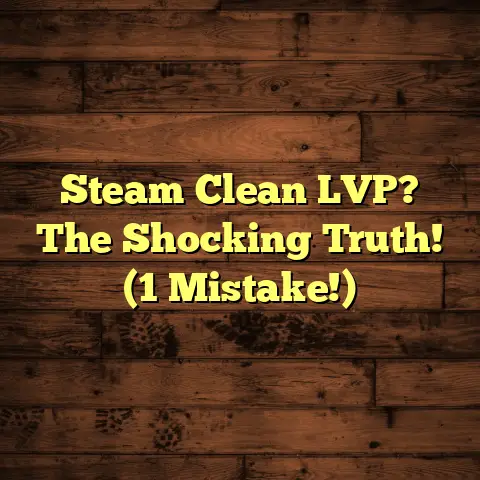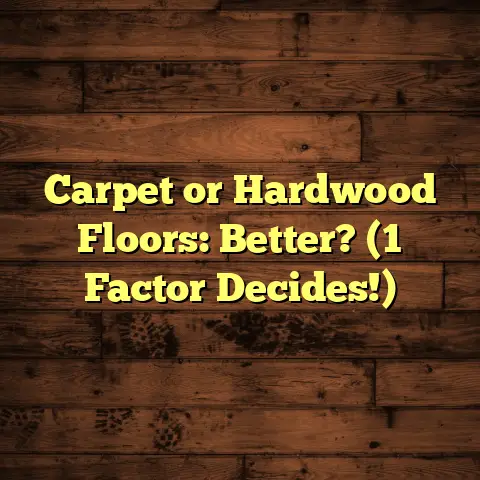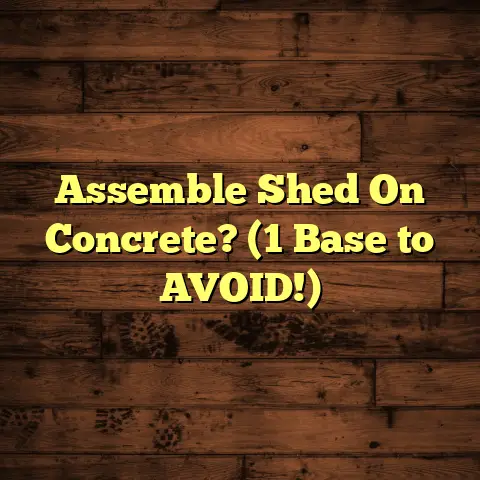How Do You Get Scuff Marks Off Of Laminate Flooring?
I know that feeling.
It’s like a little stab of frustration, right?
You think, “Ugh, how did that happen?”
Well, you’re not alone. Scuff marks are a common enemy of laminate floors everywhere.
But don’t worry!
I’m here to walk you through
everything you need to know to get rid of them
and keep your floors looking fantastic.
Section 1: Understanding Laminate Flooring
So, what exactly is laminate flooring, and why is it so popular these days?
Laminate is basically a multi-layered synthetic flooring product fused together through a lamination process.
Think of it as a high-tech sandwich:
-
Wear Layer: The top layer, a clear, protective coating that resists scratches and stains.
Decorative Layer: A high-resolution image of wood, stone, or tile.
This is what gives laminate its realistic look.-
Core Board: Made of high-density fiberboard (HDF) or medium-density fiberboard (MDF), this layer provides stability and impact resistance.
-
Backing Layer: A moisture-resistant layer that protects the core from water damage.
Laminate floors have become super popular, and that’s because they are:
-
Durable: They can withstand a lot of foot traffic and everyday wear and tear.
-
Affordable: Compared to hardwood or tile, laminate is much easier on the wallet.
-
Aesthetically Pleasing: With advancements in technology, laminate can mimic the look of real wood or stone incredibly well.
-
Easy to Install: Many laminate floors come with click-lock systems, making DIY installation a breeze.
But, despite all these benefits, laminate isn’t invincible.
Scuff marks are a common issue.
Let’s dive into that!
Section 2: Types of Scuff Marks
Alright, let’s talk scuff marks. What are they?
Well, scuff marks are those unsightly streaks or smears that appear on your floor when something rubs against the surface.
Think about it: shoes, furniture being dragged, playful pets – they all contribute to the scuff mark party.
Now, not all scuff marks are created equal.
Here are a few common types I see:
-
Rubber Scuffs: These are usually left by shoes, especially sneakers with rubber soles.
-
Dirt Scuffs: These happen when dirt or grit gets trapped under shoes or furniture and grinds against the floor.
-
Wax Scuffs: These can come from candles, crayons (kids!), or even certain cleaning products.
-
Metal Scuffs: Caused by metal objects like furniture legs without protection or dragging metal tools across the floor.
The finish on your laminate also plays a role.
Some finishes are more prone to showing scuff marks than others.
For example, a high-gloss finish might highlight scuffs more than a matte finish.
And a textured finish might trap dirt and make scuffs harder to remove.
Section 3: Tools and Materials Needed for Removal
Okay, so you’ve identified the enemy (scuff marks).
Now, let’s gear up with the right tools and materials.
Here’s a list of things you might need:
-
Microfiber Cloths: These are your best friends! Soft, absorbent, and won’t scratch the floor.
-
Soft-Bristled Brush: For gently scrubbing stubborn marks.
-
Vacuum Cleaner: To remove loose dirt and debris before cleaning.
-
Mop: For general cleaning.
-
Warm Water: Often, that’s all you need!
-
Mild Dish Soap: A few drops in warm water can work wonders.
-
Baking Soda: A gentle abrasive for tougher marks.
-
White Vinegar: Diluted with water, it can help remove greasy scuffs.
-
Pencil Eraser: Yep, the kind you used in school! Great for small, localized scuffs.
Commercial Scuff Removers: Be careful with these!
Always test in an inconspicuous area first.
I’ve had good experiences with products designed specifically for laminate floors.
Important Note: Avoid using harsh chemicals like bleach, ammonia, or abrasive cleaners.
These can damage the laminate finish and cause discoloration.
Section 4: Step-by-Step Guide to Removing Scuff Marks
Alright, let’s get down to business!
Here’s my step-by-step guide for removing scuff marks, starting with the gentlest methods:
Step 1: The Microfiber Cloth Test
- Dampen a clean microfiber cloth with warm water.
Make sure it’s not soaking wet, just damp. - Gently rub the scuff mark in a circular motion.
- Check the cloth to see if the scuff mark is transferring.
- Repeat until the scuff mark is gone or significantly reduced.
- Dry the area with a clean, dry microfiber cloth.
Step 2: Mild Soap and Water
- If the microfiber cloth alone doesn’t do the trick, add a few drops of mild dish soap to a bucket of warm water.
- Dip the microfiber cloth into the soapy water, wring it out well, and rub the scuff mark.
- Rinse the area with a clean, damp cloth to remove any soap residue.
- Dry the area thoroughly.
Step 3: Baking Soda Paste
- For tougher scuff marks, make a paste of baking soda and water.
Use about 1 tablespoon of baking soda and enough water to form a thick paste. - Apply the paste to the scuff mark and gently rub it with a soft-bristled brush or a microfiber cloth.
- Don’t scrub too hard!
- Rinse the area thoroughly with a clean, damp cloth.
- Dry the area completely.
Step 4: Vinegar Solution
- Vinegar is great for cutting through greasy scuffs.
- Mix equal parts white vinegar and water in a spray bottle.
- Lightly spray the solution onto the scuff mark.
- Let it sit for a minute or two.
- Wipe the area with a clean, damp cloth.
- Dry the area thoroughly.
Step 5: The Pencil Eraser Trick
- This works surprisingly well for small, localized scuffs.
- Simply rub the scuff mark with a clean pencil eraser.
- The eraser will lift the scuff mark right off the floor.
- Wipe away any eraser residue with a damp cloth.
Step 6: Commercial Scuff Removers
- If all else fails, you can try a commercial scuff remover.
But be very careful! - Read the instructions carefully and always test the product in an inconspicuous area first.
- Apply the product according to the instructions, and be sure to rinse and dry the area thoroughly.
Important Reminder: Always test any cleaning method in an inconspicuous area first to make sure it doesn’t damage the laminate finish.
I usually test in a closet or under a piece of furniture.
Section 5: Preventative Measures
Okay, you’ve conquered the scuff marks.
Now, let’s talk about preventing them from coming back!
Here are some tips I always share with my clients:
Use Furniture Pads: Place felt pads under the legs of all your furniture, especially chairs and tables.
This will prevent scratches and scuff marks when you move them around.Area Rugs: Use area rugs in high-traffic areas, like hallways and living rooms.
This will protect the laminate from wear and tear.Proper Footwear: Encourage family members and guests to remove their shoes when entering the house.
Or, at least, avoid wearing shoes with hard soles or heels indoors.Regular Cleaning: Sweep or vacuum your laminate floors regularly to remove dirt and debris.
This will prevent dirt from grinding against the floor and causing scuff marks.-
Use a Doormat: Place a doormat at each entrance to trap dirt and debris before they get tracked onto your floors.
Avoid Dragging: When moving furniture, lift it instead of dragging it.
If you absolutely must drag something, use a furniture dolly or protective pads.-
Trim Pet Nails: Keep your pet’s nails trimmed to prevent them from scratching the floor.
Section 6: When to Seek Professional Help
Sometimes, despite your best efforts, scuff marks just won’t budge.
Or, you might be dealing with a larger issue, like deep scratches or damage to the laminate finish.
In these cases, it’s time to call in a professional.
Here are some scenarios where professional help is recommended:
-
Persistent Scuff Marks: If you’ve tried all the methods above and the scuff marks are still visible, a professional may have access to specialized cleaning products or equipment.
-
Deep Scratches: If the scuff marks have actually scratched the laminate surface, a professional may be able to repair or replace the damaged planks.
Water Damage: If the laminate has been exposed to water, it can swell and warp.
A professional can assess the damage and recommend the best course of action.Large Areas of Damage: If a large area of your laminate floor is damaged, it may be more cost-effective to replace the entire floor.
A professional can help you choose the right type of flooring and install it properly.
Trying to remove scuff marks yourself can sometimes make the problem worse.
Using the wrong cleaning products or techniques can damage the laminate finish
and lead to discoloration or other problems.
A professional flooring contractor can assess the situation and recommend the best solution for your specific needs.
Conclusion
So, there you have it!
My ultimate guide to getting scuff marks off of laminate flooring.
Remember, maintaining laminate flooring is all about prevention and gentle cleaning.
By following these tips, you can keep your floors looking beautiful for years to come.
Don’t be afraid to experiment with different cleaning methods, but always test in an inconspicuous area first.
And if you’re ever in doubt, don’t hesitate to call a professional.
Now, I’d love to hear from you!
What are your favorite tips and tricks for maintaining laminate flooring?
Share your experiences in the comments below!
Let’s build a community of happy, scuff-free homeowners!





